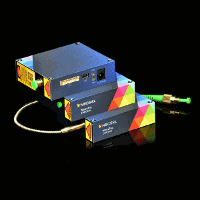Journal of Non-Crystalline Solids Volume 543, 1 September 2020, 120149
Optical properties of Er3+ heavily doped silica glass fabricated by zeolite method
Yu Yamasaki a , b , Rieko Azuma a , Yoshio Kagebayashi a , Kana Fujioka c , Yasushi Fujimoto b , c
a Ushio Inc., 1194, Sazuchi, Bessho-cho, Himeji City, Hyogo, 671-0224, Japan
b Chiba Instituite of Technology, 2-17-1 Tsudanuma, Narashino City, Chiba, 275-0016, Japan
c Institute of Laser Engineering, Osaka University, 2-6 Yamada-oka, Suita City, Osaka, 565-0871, Japan
近年,高速なレーザー加工や光周波数コム,LiDAR等の光源として,GHz程度の高繰り返し周波数が高速なファイバーレーザーが注目を集めている。高繰り返しファイバーレーザーの構築には,希土類イオンを1.0 wt.% 程度の高濃度添加した石英ガラスが必要となる。しかしながら,石英ガラス中で希土類イオンは凝集し,蛍光量子収率ηが数% 程度まで下がり,レーザー発振が難しくなる問題があった。
そこで,我々はゼオライトを希土類添加の前駆体として用いることで凝集を防ぎ(= ゼオライト法),Er3+を0.96 wt.% 添加した石英ガラスを作製することに成功した。その光学特性を計測してJudd‐Ofelt法を用いて解析した結果,ηは45.1 ± 3.3%もの高い値を示すことが分かった。
High-repetition-rate fiber lasers, ~ GHz laser, have attracted attention as light sources for high-speed laser processing, optical frequency combs, and LiDAR. For constructing a high-repetition-rate fiber laser, rare-earth ions heavily doped silica glass is required. However, rare-earth ions often forms cluster in silica glass, and reducing the fluorescence quantum yield η to several percent (= quenching).
For avoiding quenching, we used zeolite as a precursor (= zeolite method) and succeeded in fabricating Er3+ heavily doped silica glass. Quatum yield η was calculated to 45.1 ± 3.3% by using the Judd-Ofelt method.
Copyright © USHIO INC. All Rights Reserved

